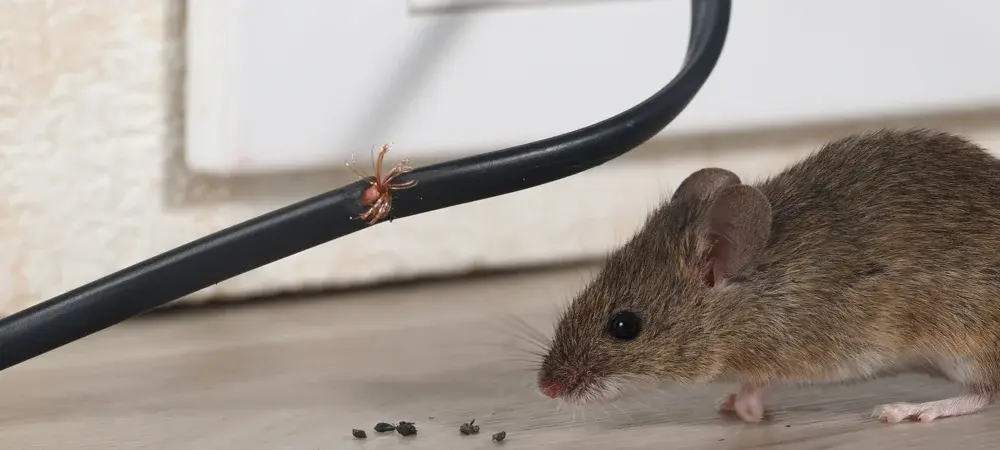How Do You Keep Mice Out of Your Home? A Guide to Mice Exclusion

Mice can be more than just a nuisance—they pose real threats to your health and property by contaminating food, transmitting diseases, and causing electrical fires by gnawing on wires. Therefore, taking preventative measures is essential to safeguard your home.
If you're a homeowner in Massachusetts, you know how common it is for mice to seek shelter in homes, especially as temperatures drop. With its cold winters and charming, older homes, Massachusetts offers prime conditions for these rodents to find their way indoors.
What is Mice Exclusion?
Mice exclusion involves sealing up any potential entry points in your home that these rodents could use to gain access. Rather than waiting until mice are already inside, exclusion focuses on preventing them from entering in the first place. This method is not only effective but environmentally friendly, as it minimizes the need for toxic rodenticides.
Common Entry Points in Massachusetts Homes
Here in Massachusetts, our homes come in all shapes, sizes, and ages. No matter where you live, mice can find their way inside if you’re not careful. The key is knowing where to look. Some common entry points include:
- Foundation Gaps: Many homes in Massachusetts have stone or brick foundations that may shift over time, creating small cracks or holes. Mice can squeeze through gaps as small as ¼ inch, making these tiny cracks an open invitation.
- Old Windows and Doors: With many of our homes dating back to the 19th or early 20th century, older windows and doors often don’t fit as snugly as they once did. Gaps between window sills or door frames are perfect access points for mice.
- Attic and Roof Areas: In areas with historic homes like Cambridge or Lexington, it's common for mice to access homes through small gaps in the roof or eaves. Check vents and chimney areas to ensure they’re secure.
- Basements and Crawl Spaces: Massachusetts is notorious for damp, unfinished basements. These areas often have cracks or small openings around utility pipes or sump pumps.
- Garage Doors: Many garages, especially detached ones, have gaps along the base of the door, allowing easy access for mice to sneak in and then move into your home.
- Vents and Ducts: Vents and ducts are often overlooked entry points for mice, especially in homes with central heating and air conditioning systems. Mice can easily enter through gaps around vent covers or ductwork that is not properly sealed.
- Utilities: Mice often use openings around utility lines as entry points into your home. Gaps around gas, water, and electrical lines can provide an easy pathway for rodents.
If you would like assistance, contact our team for a professional rodent inspection.

How To Keep Mice Out Of Your Massachusetts Home
Begin by conducting a thorough inspection of your home. Look for common entry points where mice might gain access. Then start on some exclusion strategies that will help keep your home mouse-free:
1. Seal Cracks and Holes
Inspect the exterior of your home for any cracks or gaps, especially around the foundation, windows, and doors. Seal these potential entry points:
- Use Steel Wool: Mice can chew through soft materials, but steel wool is tough for them to penetrate. Stuff steel wool into holes and cracks.
- Caulk: For smaller gaps, use a high-quality caulk to seal them. Pay special attention to areas around windows, doors, siding, ducts, vents, and utility lines.
- Weatherstripping: Install weatherstripping around doors and windows to close gaps and provide added insulation against the cold.
- Hardware Cloth: For larger openings or vents, consider using hardware cloth, which is a mesh material made from galvanized steel. It’s durable and can be cut to size to cover openings, providing an effective barrier against mice while allowing for ventilation.
2. Install Door Sweeps
If you live in an older home, installing door sweeps on exterior doors can help block mice from squeezing through the bottom. This is especially helpful during the colder months when mice are actively seeking warmth. Don’t forget to seal the door from your garage to the interior.
Secure Attics and Rooflines
Mice can easily access your home through the roof and attic, so it’s essential to secure these areas:
- Inspect Roof Vents: Ensure that roof vents are in good condition and have screens to prevent entry.
- Check Eaves and Soffits: Look for gaps in eaves and soffits where mice can enter. Seal any openings with caulk or hardware cloth.
- Repair Roof Damage: Make sure your roof is in good repair; holes or damaged shingles can provide access points for mice.
In older homes, check for loose roof shingles or gaps along the fascia boards.
3. Keep Landscaping in Check
- Trim Trees and Shrubs: Keep trees and shrubs trimmed away from the house to prevent mice from using them as pathways to your roof.
- Store Firewood Properly: Stack firewood at least 20 feet from your home and off the ground. This prevents mice from making their homes in the woodpile and then invading your space.
- Maintain Your Yard: Clear debris and tall grass around your home to reduce potential hiding spots for mice.
4. Properly Store Food
Mice are always on the hunt for food:
- Use Airtight Containers: Store all food items, including grains, sweets, and snacks, in airtight containers to deter mice. Don’t forget pet food—store it in sealed containers as well.
- Clean Up Spills Promptly: Regularly clean your kitchen and dining areas to remove any food crumbs or spills that could attract mice.
- Dispose of Garbage Properly: Use trash cans with tight-fitting lids and ensure that garbage is regularly taken out to minimize attractants.
5. Maintain Your Garage and Basement
Garages and basements can be prime nesting areas for mice if they’re cluttered. Here’s what you can do:
- Store Items in Containers: Use plastic bins with tight-fitting lids instead of cardboard boxes to store items. Mice can easily chew through cardboard.
- Keep Food Secure: If you store pet food, bird seed, or other food items in your garage or basement, ensure they are in airtight containers.
6. Monitor for Activity
Even after taking preventative measures, it’s essential to remain vigilant. Set up traps or bait stations in areas where you suspect mouse activity, such as along walls or in dark corners. Regularly check these traps to monitor for signs of intrusion.
7. Contact a Professional Rodent Exterminator
If you suspect a mouse infestation or have difficulty sealing your home effectively, don’t hesitate to reach out to a local pest control professional. In Massachusetts, there are many reputable companies that specialize in rodent control, ensuring your home stays mouse-free throughout the winter.
Sometimes, despite your best efforts, mice can still find a way inside. In that case, it’s important to reach out to a local pest control professional who is experienced with Massachusetts homes. At Clancy Brothers Pest Control, our team of rodent control experts understands the specific challenges of our climate, architecture, and environment. Plus, our professionals can provide same-day service and expert mice exclusion services tailored to your home’s needs. Contact us today!
Mice exclusion is the best long-term strategy to keep these unwelcome guests out of your home. As a Massachusetts homeowner, staying proactive is essential!
Related Posts:
